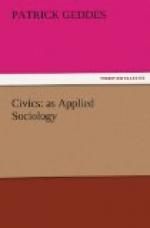river, stands the prosperous market town, the road
and railway junction upon which all the various glen-villages
converge. A day’s march further down, and
at the convergence of several such valleys, stands
the larger county-town—in the region before
me as I write, one of added importance, since not
only well nigh central to Scotland, but as the tidal
limit of a till lately navigable river. Finally,
at the mouth of its estuary, rises the smoke of a great
manufacturing city, a central world-market in its way.
Such a river system is, as geographer after geographer
has pointed out, the essential unit for the student
of cities and civilisations. Hence this simple
geographical method of treatment must here be pled
for as fundamental to any really orderly and comparative
treatment of our subject. By descending from
source to sea we follow the development of civilisation
from its simple origins to its complex resultants;
nor can any element of this be omitted. Were
we to begin with the peasant hamlet as our initial
unit, and forget the hinterlands of pasture, forest,
and chase (an error to which the writer on cities
is naturally prone), the anthropologist would soon
remind us that in forgetting the hunter, we had omitted
the essential germ of active militarism, and hence
very largely of aristocratic rule. Similarly,
[Page: 106] in ignoring the pastoral life, we
should be losing sight of a main fount of spiritual
power, and this not only as regards the historic religions,
but all later culture elements also, from the poetic
to the educational. In short, then, it takes
the whole region to make the city. As the river
carries down contributions from its whole course, so
each complex community, as we descend, is modified
by its predecessors. The converse is no doubt
true also, but commonly in less degree.
In this way with the geographer we may rapidly review
and extend our knowledge of the grouping of cities.
Such a survey of a series of our own river-basins,
say from Dee to Thames, and of a few leading Continental
ones, say the Rhine and Meuse, the Seine and Loire,
the Rhone, the Po, the Danube—and, if possible,
in America also, at least the Hudson and Mississippi—will
be found the soundest of introductions to the study
of cities. The comparison of corresponding types
at once yields the conviction of broad general unity
of development, structure, and function. Thus,
with Metschnikoff we recognise the succession of potamic,
thalassic, and oceanic civilisations; with Reclus we
see the regular distribution of minor and major towns
to have been largely influenced not only by geographical
position but by convenient journey distances.
Again, we note how the exigencies of defence and of
government, the developments of religion, despite all
historic diversities, have been fundamentally the
same. It is not, of course, to be forgotten how
government, commerce, communications, have concentrated,
altered or at least disguised the fundamental geographical




